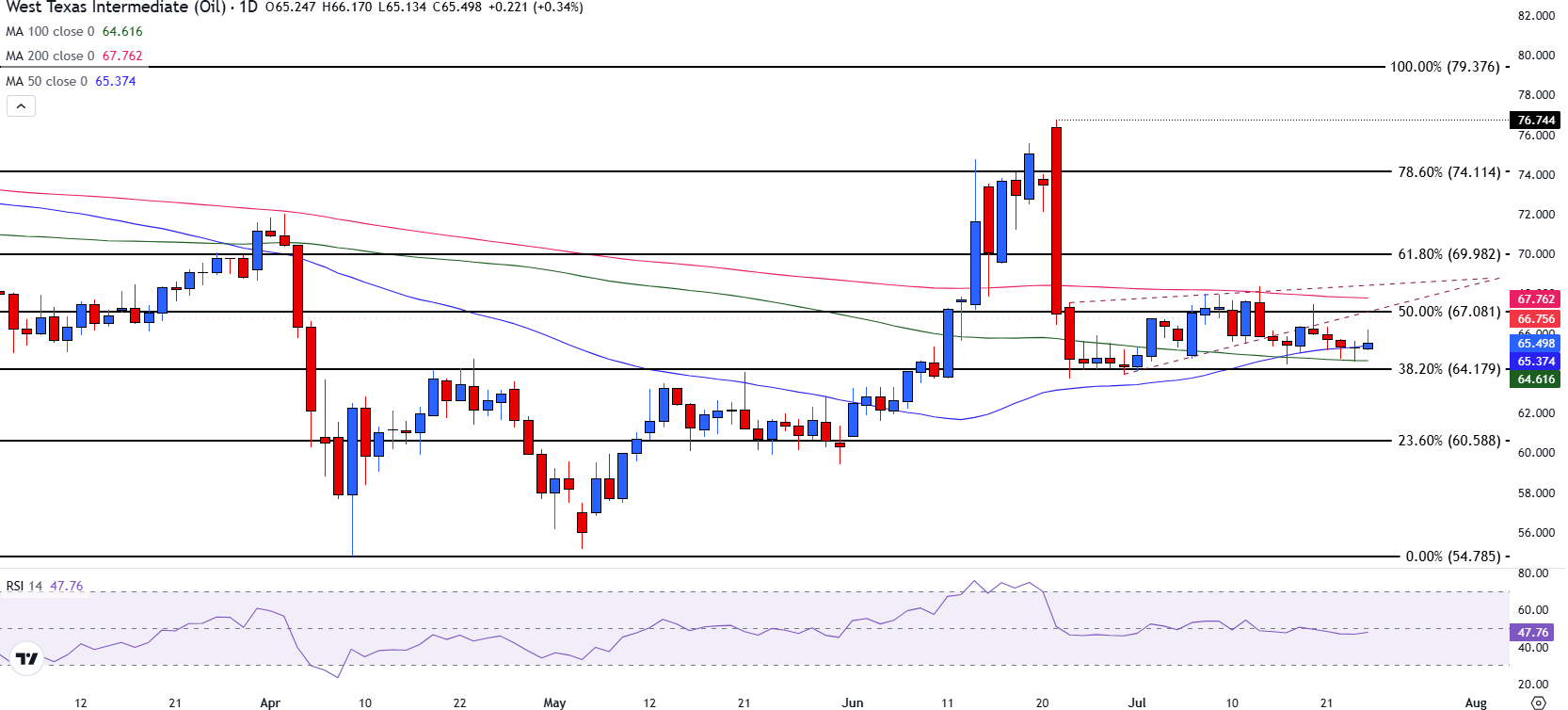- WTI crude oil is recovered with technicians suggesting a possible breakout as consolidation is constructed.
- Petroleum has volatile movements as the relaxation of commercial tensions raises demand perspectives.
- The president of the USA Donald Trump restores the Chevron license to operate in Venezuela.
The West Texas Intermediate (WTI) is trying a breakout while operators weigh contradictory signs of supply and demand.
At the time of writing, the WTI is traded about $ 66.00, with profits close to 1%.
The relaxation of commercial tensions and the improvement of demand expectations have been compensated by the increase in the production of Opec+ and the news that the Trump administration has restored Chevron’s license to produce oil in Venezuela.
An article from the Wall Street Journal published Thursday reported that the Trump administration has restored Chevron’s license to pump oil in Venezuela.
This reverses a revocation of early this year. The measure follows an exchange of prisoners in which Venezuela released 10 Americans detained last Friday.
Chevron re -authorization marks a significant change in politics and potentially opens the door to an increase in oil exports from the South American nation despite years of severe US sanctions.
The Biden administration had previously allowed Chevron to participate in limited operations in Venezuela under strict conditions. That license was terminated at the beginning of the year with Trump’s return to the office.
The new authorization paves the way for Chevron to resume the extraction of crude oil in the country, which has the largest tested oil reserves in the world.
While the underlying global demand faces winds against commercial tensions, the new critical factor on the supply side is the change of US policy.
This development, seen as a possible movement to increase the offer and manage geopolitical influence, is probably contributing to the current indecision in the WTI market and could limit the upward potential as operators consider the perspective of a greater flow of crude oil from Venezuela.
WTI crude oil maintains an adjusted range while technicians suggest a possible breakout
From a technical perspective, the WTI crude remains confined within a range that narrows despite the efforts of the bullies to overcome the range of $ 66.00. The recent movement has allowed the price to recover above the support level of the single mobile average (SMA) of 50 days at 65.38, and the 100 -day SMA is providing support in 64.62.
On the positive side, a movement above the psychological level of $ 66.00 and a rupture of the level of 50% fibonacci of the January-April fall about $ 67.00 could open the door for the 200-day SMA at 67.76.
In contrast, if bassists earn a traction below the 100 -day SMA and break the level of 38.2% fibo of $ 64.18, this could take prices back to the level of $ 62.00, which was last tested in June.

The relative force index (RSI) remains about 50, reflecting a neutral impulse background and reinforcing the current market indecision. For now, the WTI is in a waiting pattern, with the operators, observing a decisive movement that could define the next directional trend.
WTI oil – frequent questions
WTI oil is a type of crude oil that is sold in international markets. WTI are the acronym of West Texas Intermediate, one of the three main types that include the Brent and Dubai’s crude. The WTI is also known as “light” and “sweet” by its relatively low gravity and sulfur content, respectively. It is considered high quality oil that is easily refined. It is obtained in the United States and is distributed through the Cushing Center, considered “the crossing of the world.” It is a reference for the oil market and the price of WTI is frequently traded in the media.
Like all assets, supply and demand are the main factors that determine the price of WTI oil. As such, global growth can be a driver of the increase in demand and vice versa in the case of weak global growth. Political instability, wars and sanctions can alter the offer and have an impact on prices. OPEC decisions, a group of large oil -producing countries, is another key price factor. The value of the US dollar influences the price of WTI crude oil, since oil is mainly traded in US dollars, so a weaker dollar can make oil more affordable and vice versa.
Weekly reports on oil inventories published by the American Petroleum Institute (API) and the Energy Information Agency (EIA) influence the price of WTI oil. Changes in inventories reflect the fluctuation of supply and demand. If the data show a decrease in inventories, it can indicate an increase in demand, which would raise the price of oil. An increase in inventories may reflect an increase in supply, which makes prices lower. The API report is published every Tuesday and that of the EIA the next day. Their results are usually similar, with a 1% difference between them 75% of the time. EIA data is considered more reliable, since it is a government agency.
The OPEC (Organization of Petroleum Exporting Countries) is a group of 13 nations oil producing that collectively decide the production quotas of member countries in biannual meetings. Their decisions usually influence WTI oil prices. When OPEC decides to reduce fees, it can restrict the supply and raise oil prices. When OPEC increases production, the opposite effect occurs. The OPEC+ is an expanded group that includes another ten non -members of the OPEC, among which Russia stands out.
Source: Fx Street
I am Joshua Winder, a senior-level journalist and editor at World Stock Market. I specialize in covering news related to the stock market and economic trends. With more than 8 years of experience in this field, I have become an expert in financial reporting.







